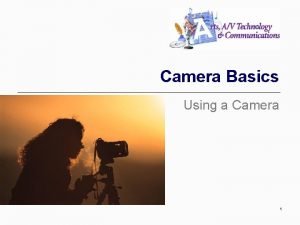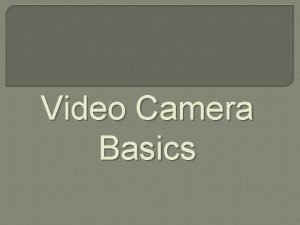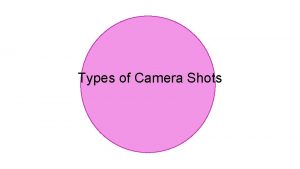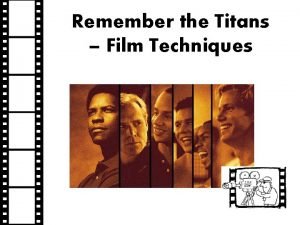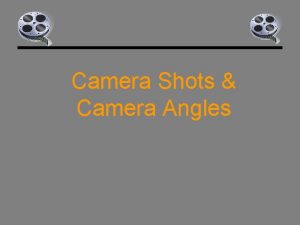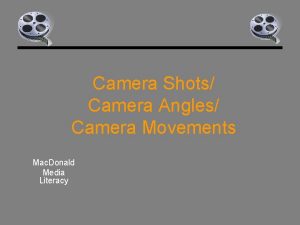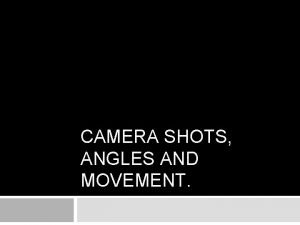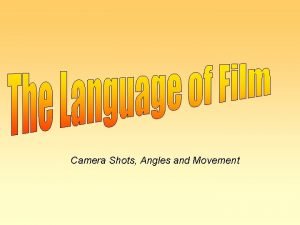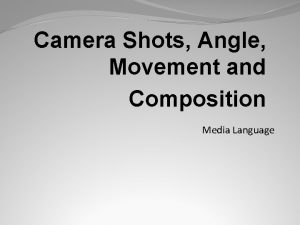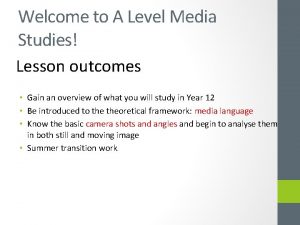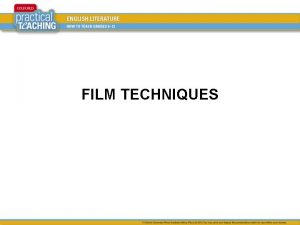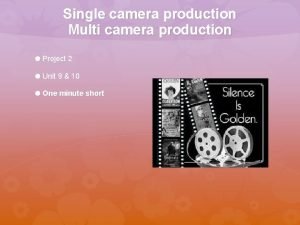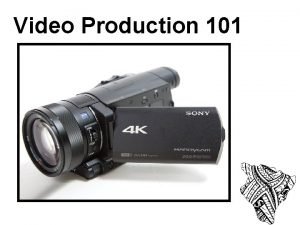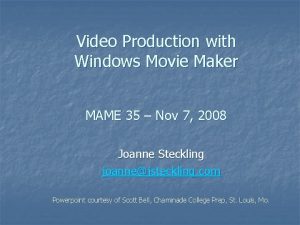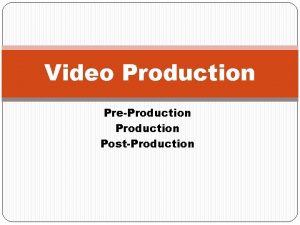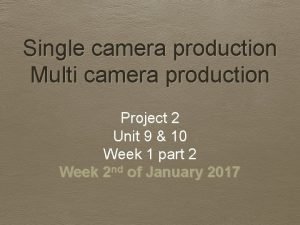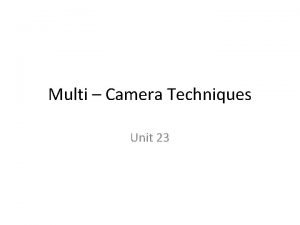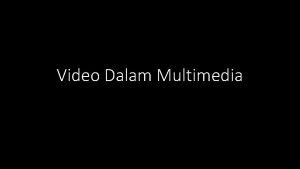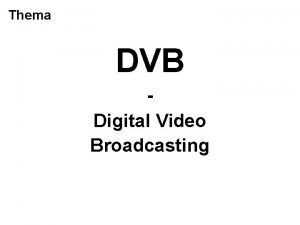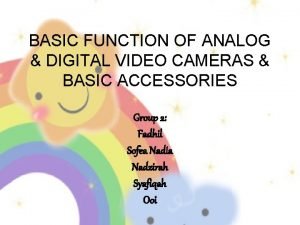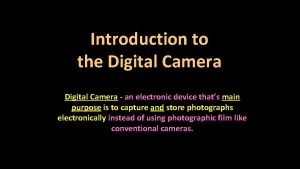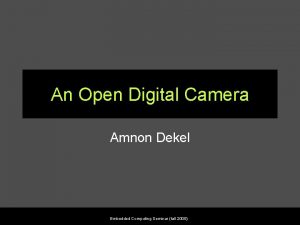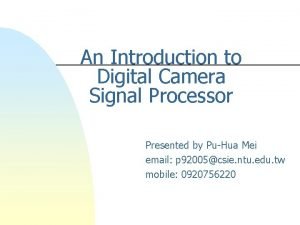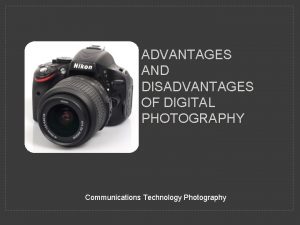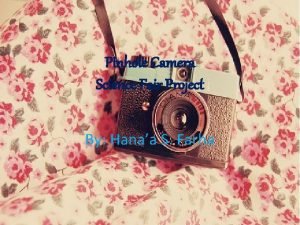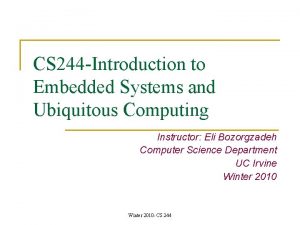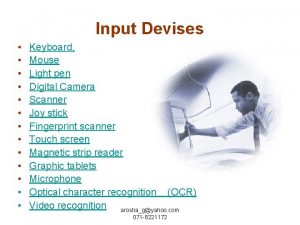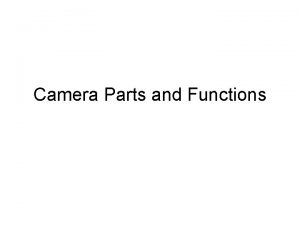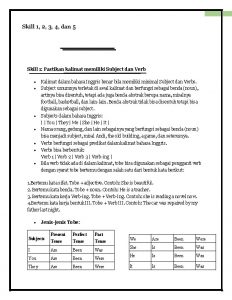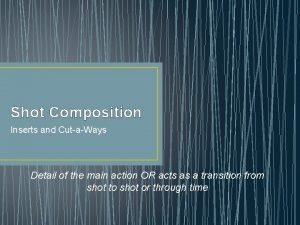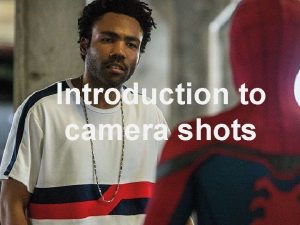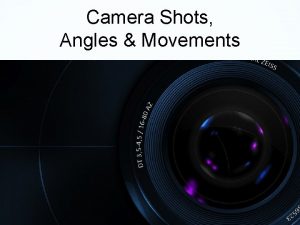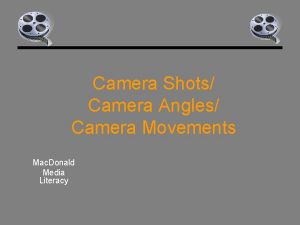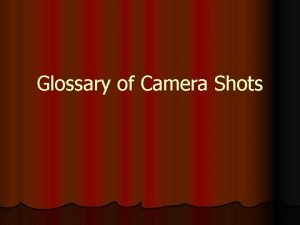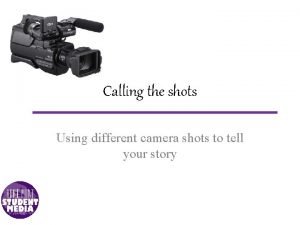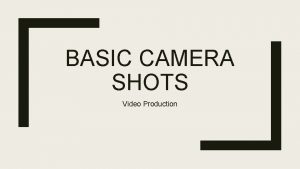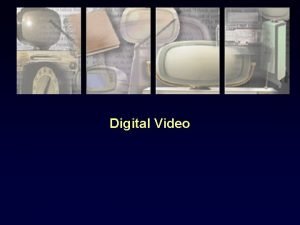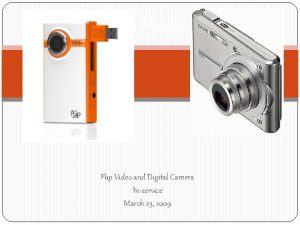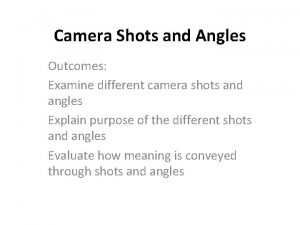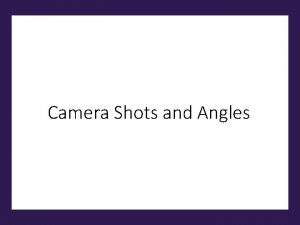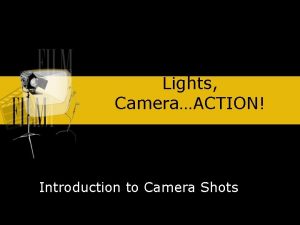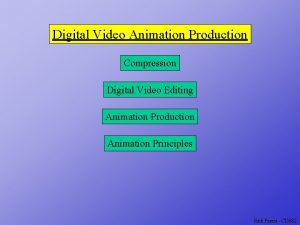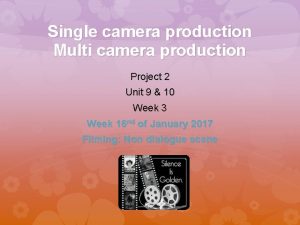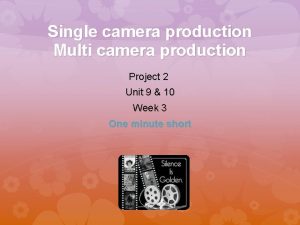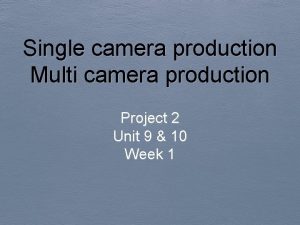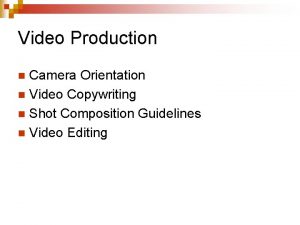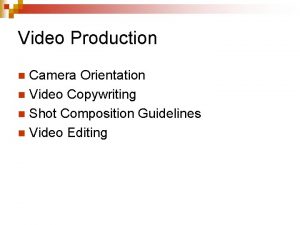Digital Video Production Camera Shots Camera Shots There




















































- Slides: 52

Digital Video Production Camera Shots

Camera Shots ¡ There are three basic camera shots: Long Shot l Medium Shot l Close Up Shot l

Long Shot - LS

Long Shot - LS Also known as the Establishing Shot or Wide Shot ¡ Shows the whole scene ¡ Frequently productions begin with a LS ¡

Long Shot - LS It sets the stage/scene - the viewer knows where she or he is ¡ LS works well if there's a lot of action ¡ LS shows a person from head to toe. ¡

Medium Shot - MS

Medium Shot - MS MS shows less of the scene then LS ¡ The camera seems closer to the subject (although it may not be if you use your zoom lens) ¡ MS shows them from about the waist up in a medium shot ¡

Medium Shot - MS Use MS when you want a closer look at your subject ¡ Use MS to transition between long shots and close up shots ¡ It is difficult for the viewer to follow what you are doing if you go straight from a LS to a CU shot ¡

Close Up Shot - CU

Close Up Shot - CU This shot shows just the head ¡ CU is used to reveal details and focus the viewer attention ¡ Extra consideration is needed for the framing of a CU because any camera movement is exaggerated ¡

Other Camera Shots ¡ Other camera shots include: l Extreme Close Up Shot l Extreme Long Shot l Over the Shoulder Shot l Cut Away Shot l Two/Three Shot

Extreme Close Up Shot - ECU

Extreme Close Up Shot - ECU ECS is sometimes referred to as XCU ¡ Closer than to the subject than CU ¡ ECU is just of the person's eyes ¡

Extreme Long Shot - ELS

Extreme Long Shot - ELS is sometimes referred to as XLS ¡ ELS shows a large view that includes that subject from a distance ¡ ELS is relative to what is considered a LS ¡

Over the Shoulder Shot - OS OS is commonly used in ENG – Electric News Gathering ¡ Videographer is literally shooting over the shoulder of the person being interviewed ¡ Usually a shot of the interviewer listening, nodding, or responding to the interviewee ¡

Cut Away Shot - CA CA is usually a CU or XCU that reveals some detail – as the telephone rings during a MS scene the shot changes to a CA of the telephone ¡ A very useful shot that provides a natural transition in the editing process ¡

Two/Three Shot - TS TS a two shot has two people or three people in the frame ¡ Usually a MS or LS because you need some distance from the people to get them all in the frame ¡

Shot Angles ¡ There are three basic shot angles: Eye Level l Low Angle l High Angle l

Shot Angles Your shot angle is the level from which you look at your subject. ¡ Your shot angle can change the way the viewer responds to the scene – consider the response to someone speaking to you at eye level to that of speaking to you from above. ¡

Eye Level Angle - EL

Eye Level Angle - EL The most common used shots is the eye level shot ¡ It's the most familiar perspective we usually see things from our own eye level ¡ Make sure you shoot at their eyelevel, not yours ¡

Low Angle - LA

Low Angle - LA In this shot the camera looks up at the subject ¡ Making it seem important, powerful, or perhaps larger than it is to the viewer ¡

High Angle - HA

High Angle - HA Camera looks down on the subject, decreasing its importance ¡ The subject looks smaller ¡ It often gives the audience a sense of power, or the subject a sense of helplessness ¡

Other Shot Angles ¡ Other shot angles include: Birds Eye Angle l Reverse Angle l Point of View Angle l

Bird’s Eye Angle - BE Camera is mounted on a crane or ladder ¡ This is an extreme angle the point of view from above ¡ This angle is often used in car chases and in the “happy ever after” fade out ¡

Reverse Angle - RA A reverse angel is determined by the framing of the previous shot ¡ A reverse is used to shoot two people facing each other cutting from one person to another ¡

Point of View - POV This camera angle shows a specific POV so the audience has the perspective of seeing through someone else’s eyes ¡ This shot has become very popular in recent years and often shows unique POVs – security cameras, animals, aliens etc… ¡

Shot Movements ¡ There are six moves: l Pan l Tilt l Zoom l Dolly l Truck l Arc

Pan Shot A pan shot taken by moving the camera on across a horizontal plane ¡ Used in action and sports shots ¡ This shot emphasizes action and physical movement ¡

Tilt Shot The camera moves up or down a vertical plane ¡ A tilt can be used to shot something that is too big to fit within frame ¡ This shot emphasizes size and proportion ¡

Pan and Tilt Shot The pan and tilt are most effective when combined with the tripod ¡ These shots can be successfully achieve hand held with practice ¡

Zoom Shot This shot moves the audience closer into the subject ¡ The camera remains stationary and the focal length of the lens is pulled ¡ A reverse zoom moves out from the subject ¡ The zoom shot focuses the viewers attention, while the reverse is used to transition out ¡

Zoom Shot Zoom shots work successfully when the movement is smooth and steady ¡ Most cameras have external toggles for zoom controls ¡

Dolly Shot A Dolly shot moves towards or away from the subject ¡ The camera is physically moved not changing of the focal length of the lens ¡ Dolly in moves towards the subject ¡ Dolly out moves away from the subject ¡

Dolly Shot A Dolly also refers to a camera mount with wheels ¡ Some dollies move along tracks ¡ Storyboarding is necessary to achieve this shot ¡ Dolly in Dolly Out

Truck Shot The camera physically follows the subject matter left to right or right to left ¡ Used in walking shots to follow the subject ¡ The camera is usually on a dolly and in large budget productions has tracks ¡

Truck Shot ¡ This movement is called trucking

Arc Shot The subject stays stationary in the centre while the camera moves around in an arc left or right ¡ A continuous arc makes a complete circle around the subject. ¡ This shot is often used in music videos and romantic scenes ¡

Arc Shot

Shot Movements ¡ ¡ ¡ Rapid pans, tilts, repeated zooms can make your audience feel motion sick The standard shot rule is stationary – motion – stationary If you edit or cut away in the middle of movement, you may make your viewer disoriented

Shot Movements ¡ There are five basic ways to achieve shot and camera movement: l Hand held l Camera Lens l Tripod l Dolly l Steadicam

Shot Lengths ¡ ¡ The length each shot depends on the scene and what you want to accomplish An action shot may last 20 sec A still shot may only last 3 sec Your goal is to gain and hold the audience's attention and understanding

Review ¡ ¡ Camera Shots Camera Angles Camera Movements Camera Supports

Camera Shots ¡ There are three basic camera shots: Long Shot l Medium Shot l Close Up Shot l

Other Camera Shots ¡ Other camera shots include: Extreme Close Up Shot l Extreme Long Shot l Over the Shoulder Shot l Cut Away Shot l Two/Three Shot l

Shot Angles ¡ There are three basic shot angles: Eye Level l Low Angle l High Angle l

Other Shot Angles ¡ Other shot angles include: Birds Eye Angle l Reverse Angle l Point of View Angle l

Shot Movements ¡ There are six shot movement: l l l Pan Tilt Zoom Dolly Truck Arc

Shot Movements ¡ There are five ways to achieve shot or camera movement: l l l Tripod Hand held Camera Lens Dolly Steadicam
 Jelaskan 3 proses alur produksi multimedia
Jelaskan 3 proses alur produksi multimedia Video camera basics
Video camera basics Video camera functions
Video camera functions Type of shots
Type of shots Slidetodoc.com
Slidetodoc.com Camera shots and angles quiz
Camera shots and angles quiz Long shot camera shot
Long shot camera shot Shot types
Shot types Camera angle
Camera angle Tracking shot
Tracking shot Media camera shots
Media camera shots Camera shots
Camera shots Example of camera shots
Example of camera shots Camera shots media studies
Camera shots media studies Visual techniques in film
Visual techniques in film Videos yandex search
Videos yandex search Yahoo search video
Yahoo search video Yahoo.com.yw
Yahoo.com.yw Digital media primer
Digital media primer Polycom video conferencing setup
Polycom video conferencing setup Why use single camera production
Why use single camera production Camera movement
Camera movement Video production 101
Video production 101 Video production maker
Video production maker Pre production planning for video film and multimedia
Pre production planning for video film and multimedia What is single camera production
What is single camera production Multi camera shooting techniques
Multi camera shooting techniques Video berasal dari kata
Video berasal dari kata Sdv video
Sdv video Analog and digital video in multimedia
Analog and digital video in multimedia Introduction digital video
Introduction digital video Digital vs analog video
Digital vs analog video Dvb digital video broadcasting
Dvb digital video broadcasting Analog vs digital video
Analog vs digital video A digital camera is an electronic device
A digital camera is an electronic device Digital camera input process output
Digital camera input process output Camera parts and functions
Camera parts and functions Digital camera embedded system
Digital camera embedded system Digital camera processors
Digital camera processors Advantages of digital camera
Advantages of digital camera Pinhole camera class 6 project
Pinhole camera class 6 project Cs 244
Cs 244 Keyboard mouse scanner digital camera are
Keyboard mouse scanner digital camera are Input devises
Input devises Single-lens reflex camera parts and functions
Single-lens reflex camera parts and functions Embedded systems design
Embedded systems design Jelaskan kategori multimedia secara garis besar
Jelaskan kategori multimedia secara garis besar Sarah rarely misses her basketball shots
Sarah rarely misses her basketball shots Insert shot vs cutaway
Insert shot vs cutaway Premade jello shots
Premade jello shots Bb shots in pap smear
Bb shots in pap smear Cut away shot
Cut away shot Lighting in citizen kane
Lighting in citizen kane

